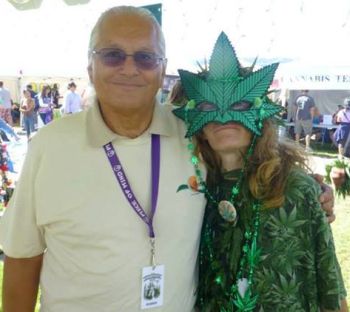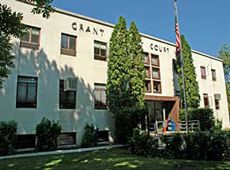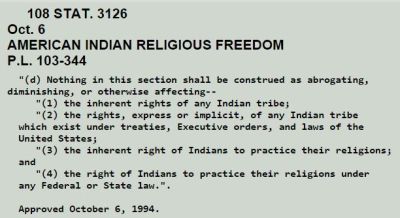
Publisher:
Bonnie King
CONTACT:
Newsroom@Salem-news.com
Advertising:
Adsales@Salem-news.com

~Truth~
~Justice~
~Peace~
TJP
Dec-03-2014 04:20

 TweetFollow @OregonNews
TweetFollow @OregonNews
13 Little Pot Plants May Set Religious Sacrament Standard for Oregon
Bonnie King Salem-News.comThis milestone cannabis case continues Thursday, December the 4th, at 3:45 at the Grant county courthouse in Canyon City, Oregon for defendants of the ONAC KM Sanctuary Garden Raid. The public is invited to attend.
 Oklevueha Native American Church of Kautantowit's Mecautea began its birth in August of 2013 between 'Flaming Eagle' and Sachem healer Joy Graves in Seattle, Washington. |
(SALEM, Ore.) - “This case will liberate Cannabis Indica and Cannabis Ruderalis from prosecution once-and-for-all as they are not federally controlled substances. It will also ensure our civil rights, liberties and freedoms regarding Mother Earth's healing sacraments for all native born American peoples - hopefully even beyond those borders as well,” said Joy Graves, Sachem Healer of the Oklevueha Native American Church.
On October 31, 2014, defendants Joy Maxine Graves and Raymond Scott Martin stood in in the courtroom of Grant County Circuit Judge William D. Cramer Jr., the latest episode in the ongoing real-life drama began last June, when 13 small cannabis plants were yanked from the soil in Seneca.
 Grant County Court |
The would-be drug raid has since revealed itself as a religious freedom case, and may be of limited importance on any other footing.
Discrepancies between state and federal laws where cannabis/marijuana is concerned is something to be expected until prohibition is lifted at the federal level. At the state level, however, Oregon voters have been loud and clear. They are tired of the money and energy going into chasing down and prosecuting petty pot offenders. Oregon passed a marijuana legalization measure on November 4th, which goes into effect on July 1, 2015.
For authorities, it seems the question is whether the newly planted garden was medicinal, sacramental or simply another run-of-the-mill illegal marijuana grow.
Joy Graves says the sacramental garden was specifically for the church, and they are supported by the elders of the Native American Church (ONAC KM).
Defendants Graves and Martin maintain that cannabis is an earth-based sacrament central to the rites of their branch of the Oklevueha Native American Church of Kautantowits Mecautea (ONAC KM), of which they belong.
Attorneys for Graves and Martin moved to dismiss the case, contending it conflicts with their clients’ right to religious freedom, but instead, there was a continuance.
The new court date is this Thursday, December 4th at 3:45 p.m.
This case is expected to set a new standard in the state of Oregon in regard to the acceptable use of cannabis as a religious sacrament. The sacrament Cannabis is nothing new for many Native American Churches, but it is generally unknown outside the limited congregations the churches serve, until now.
A Small Catch for a Costly Trial
The case of the 13 little pot plants began June 14, 2014, when Grant County Sheriff’s deputies showed up at Graves’ Seneca property to check out a suspected marijuana grow.
There were two men on the property, sacramental garden caretakers, 36-year old Martin of Cameron, Mo., and 42-year old Kenny Walters, of Walla Walla, Wash. Both were arrested for “manufacture of a controlled substance” and “possession within 1,000 feet of a school”.
The tallest plant was 8 ½” tall. INCHES.These were absolutely not consumable products by any stretch of the imagination, and according to experts, marijuana plants don’t start making THC until they reach the flower cycle, which was many weeks off for these young starts. The pot case may just be discarded once this factoid finds its way to the Court.
The property owner, Joy Graves, who did not participate in the planting of the garden and was not present at the search, was indicted in July by a grand jury, charging her with manufacturing marijuana within 1,000 feet of a school. Graves did not have an active OMMP permit at the time, as it had lapsed temporarily, but she has since rectified that problem.
At the arraignment in August, Graves’ case was consolidated with co-defendant Raymond "Scott" Martin per the judge’s request.
Then, the court disallowed the two from communicating.
“They created quite a conundrum. Though the court wanted us standing as one defense, we were not allowed contact with one another, which made things fairly interesting,” Graves said.
As for the third Defendant, Kenny Walters, he’s nowhere to be seen. He fled the area soon after his initial release, and so the case against him is in limbo.
So far, this case has cost Grant County a relatively small investment, but as it moves forward will continue to gain momentum in expense to the tax payer. With popular support going toward fewer pot arrests, and this particular one so sensational, the question at hand for inquiring minds is simply, “What do they hope to win?”
Statute has no regard for Religion or Affiliation
Deputy District Attorney Matthew Ipson said that “the state law prohibiting marijuana grows within 1,000 feet of a school is a statute of general applicability.” In court filings, he states: “the statute is applied equally without regard to religious beliefs or affiliation”.
First, Religion. In this case, not appreciating that this is an Indian church with the protections afforded them through the Federal government, specifically the American Indian Religious Freedom Act, draws attention to the ambiguity built into individual interpretations of the general applicability statute.
Next, Affiliation. Are the defendants affiliated with Indians, and Indian tribes? Yes, they are. “Affiliation” may count in this case after all.
That, in itself, may be worthy of a trip to the Supreme Court. In 1985, the Ninth Circuit1 said that a statute of general applicability will be held inapplicable to Indians if:
(1) it would interfere with tribal governance, or
(2) it would clash with the rights granted Indians by other statutes or by treaties with Indian tribes, or
(3) there is persuasive evidence that Congress did not intend by its silence that the statute would apply to Indians.
Prior to that statement, courts generally followed Elk v. Wilkins, 112 U.S. 94(1884) which stated that "[g]eneral acts of Congress do not apply to Indians, unless so expressed as to clearly manifest an intention to include them."
Whichever way it is looked at, there is little question as to whether the removal and destruction of their religious sacrament (cannabis) clashes with the rights granted Indians.
Protection from the Puny Pot Plot
As the crow flies, the nearest school is just over 400 feet from Graves’ property. The true measurement would be much further, should pedestrians chose to use the sidewalk instead of flying overhead.
Schools had been dismissed for summer before this event took place - before the garden was planted, and before the search, seizure and arrests. The imminent risk, however perceived, was negligible.
“The sheriff said that if it was a medical marijuana grow they’d overlook it, because it would be legal,” Graves said. “And that must be true, because there is a medical marijuana grow right across from the school, and they simply do not care.”
“Overlooking a medical grow while attacking a church grow means you’re missing the point of the law. The Color of the Law should rule here,” Graves said, “but instead, here we are, much further from the school, growing our religious sacrament and completely targeted as if we were criminals. This is a church; we are not breaking the law.”
In fact, Graves has applied for her Oregon Medical Marijuana Permit, and is awaiting the arrival of her official verification. In the meantime, she is a legal patient, with temporary paperwork.
Joy Graves was one of the forerunners in the medical marijuana movement. She helped gather signatures with John Sajo in 1998 and assisted the first OMMP manager in creating the OMMP applications still used today.
“Jack Herer helped draft the OMMP and I helped get signatures,” Graves said. Jack Herer was a renowned author and pro-marijuana/hemp activist. He wrote the notorious book, “Emperor Wears No Clothes” that has sold over 600,000 copies since its first edition in 1985. Jack Herer died in 2010.
“Jack demanded that I get my card, and it saved my life, as it continues to. He said to give back what I owe to the plant for saving me, to the community that needs it. And that’s what I do. That’s my pact with Jack, like the one he made with "Captain" Ed Adair so long ago,” Graves said.
American Indian spiritual leader Flaming Eagle Affirms Cannabis as Sacrament
“I think it's most important to thank and highly praise James Warren 'Flaming Eagle' Mooney for testifying as our primary witness. He did absolutely amazing speaking in defense of our church, Oklevueha Native American Church, and especially on behalf of cannabis sacrament,” Joy Graves reported.
American Indian spiritual leader and Church founder, James “Flaming Eagle” Mooney of Utah was the first testimony heard at the October 31st hearing, via telephone. He said cannabis has been used “for thousands of years” in religious rites.
He directly said that not being able to use it would interfere with the church’s ability to perform rites with its members, and would be like prohibition.
Prosecutors did not object.
Defendant Martin’s attorney Robert Raschio argued that the Native American Church uses cannabis “in the sincere practice of its religious principles”, in a court filing.
In a later interview Raschio explained that the government allows religious uses of substances that are otherwise controlled. “For example, federal law allows peyote in Native American services, and mainstream churches can give wine to minors for communion rites,” he said.
Timothy Gassner, Graves’ attorney, argued the state has no compelling interest in overriding his client’s use of cannabis in her religious practice.
The Supreme Court's controversial decision in Oregon v. Smith is historic: In 1983, two Klamath Indians were fired for using peyote, a controlled substance under Oregon law, in a religious ceremony of the Native American Church. They were denied unemployment benefits, and argued that the denial of unemployment benefits constituted an infringement of their religious freedom. They won in a landmark case for the Indian cause. Author Carolyn Long said it also led to an intense tug-of-war between the Court and Congress, which fought back with amendments to the American Indian Religious Freedom Act (to protect the religious use of peyote).
The American Indian Religious Freedom Act (AIRFA), Public Law No. 95-341, 92 Stat. 469 (Aug. 11, 1978), codified at 42 U.S.C. § 1996, is a United States federal law, enacted by joint resolution of the Congress in 1978. It was enacted to protect and preserve the traditional religious rights and cultural practices of American Indians, Eskimos, Aleuts, and Native Hawaiians. These rights include, but are not limited to, access to sacred sites, freedom to worship through ceremonial and traditional rights, and use and possession of objects considered sacred.
In October 1994, an important amendment was added specifically to protect the sacred plants: 42 U.S.C. § 1996a.

President Jimmy Carter said, in a statement about the AIRFA:
“In the past, Government agencies and departments have on occasion denied Native Americans access to particular sites and interfered with religious practices and customs where such use conflicted with Federal regulations. In many instances, the Federal officials responsible for the enforcement of these regulations were unaware of the nature of traditional native religious practices and, consequently, of the degree to which their agencies interfered with such practices. This legislation seeks to remedy this situation.”
Section 2 of the AIRFA directs federal agencies to consult with American Indian spiritual leaders to determine appropriate procedures to protect the inherent rights of American Indians, as laid out it the act. Joy Graves and James Warren 'Flaming Eagle' Mooney are two such individuals.
Graves said that the Prosecutor, Deputy District Attorney Matthew Ipson, was “seemingly at a complete loss as to why "Religion" was being discussed in this case.”
“Still, he chose not to object to each and everything we requested was admitted into evidence.
“The DA came into the courtroom, but indicated to the Prosecutor with hand motions several times that he was not getting involved in this one,” Graves said. Graves then took the stand. She told the Court she has been “a frontline cannabis fighter” for more than 30 years, and she established her Oklevueha church branch in late 2013. She said cannabis has saved her life, and also is providing a better path for tribal member Raymond Scott Martin from a troubled past.
Graves testified that she uses both cannabis and tobacco along with meditation and prayer in a variety of rites. “We say we make smoke,” she explained.
“As clearly and coherently as I could, I stated that they had no jurisdiction, period; I pointed out my three key justifications as to why this is true. One, we are a church. Two, we are Native American. And three, Cannabis Indica is not a Federally Controlled Substance!” Graves told Salem-News.com.
Sincerity of Religious Commitment
When it came time to address the "reconsideration" of Graves’ right and ability to use her sacramental medicine, the court said there “was not time" to address it then. She said she was not given a chance to present her proof of OMMP application/permit, and so the Judge did not have opportunity to take that legal standing into consideration at this hearing.
Deputy District Attorney Matthew Ipson agreed to remove the question of the "Sincerity" of co-defendant Raymond Scott Martin's religious involvement with ONAC.
Grant County Circuit Judge William D. Cramer Jr. granted Graves an extension on the motion filing, and also agreed to remove the "No contact order" between the two co-defendants, and gave Graves permission to contact Martin for spiritual counseling.
“He said that because I am his religious leader, we now will be given the right to communicate with one another,” Graves said.
“But the judge said on the record "you guys can't use your sacrament Cannabis while you interact, and no hanging out with one another, you can interact for religious reasons only."
Regardless of the difficulties this case has posed, Graves felt empowered by the October hearing.
“This was a History Making day and even though the right legal course of action has yet to surface in our near future – a huge thing took place. The judge acknowledged our church as valid, and recognized cannabis as our sacrament!” Graves said.
The next court appearance is THURSDAY, DECEMBER 4, 2014 at 3:45 p.m.; Grant County Courthouse is located at 201 S. Humbolt Street, Canyon City, OR 97820 (on Highway 395 about 3 miles south of the city of John Day)
1. Donovan v. Coeur d'Alene Tribal Farm (751 F.2d 1113, 1985)
2. http://www.npaihb.org/images/resources_docs/weeklymailout/2010/april/week2/$GM_10-047_OSHA_Applies_to_TribalBusiness.pdf
 |
Articles for December 3, 2014 | Articles for December 4, 2014



googlec507860f6901db00.html


Terms of Service | Privacy Policy
All comments and messages are approved by people and self promotional links or unacceptable comments are denied.
Jon T April 16, 2016 5:11 am (Pacific time)
These people are not native american they are white. Why is that part always overlooked
[Return to Top]©2025 Salem-News.com. All opinions expressed in this article are those of the author and do not necessarily reflect those of Salem-News.com.